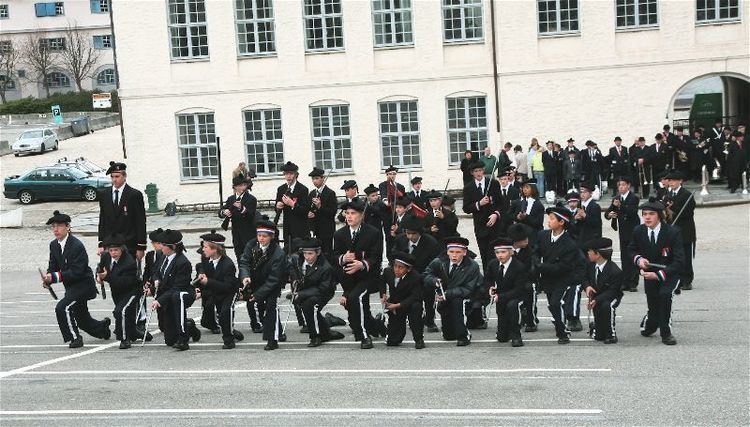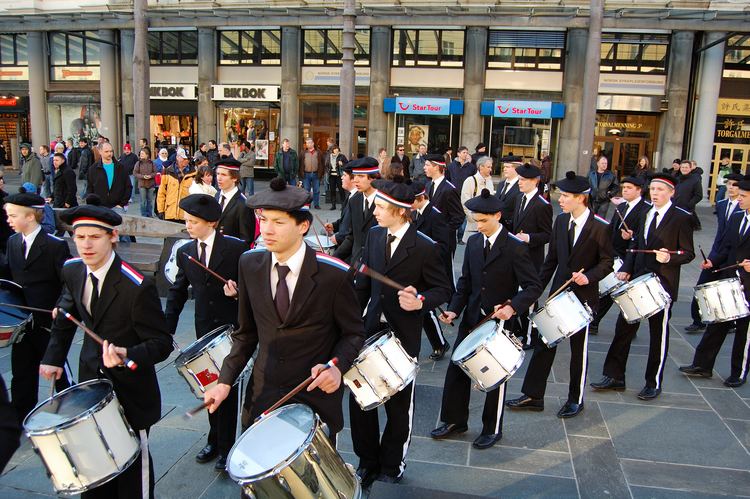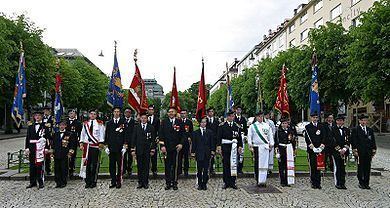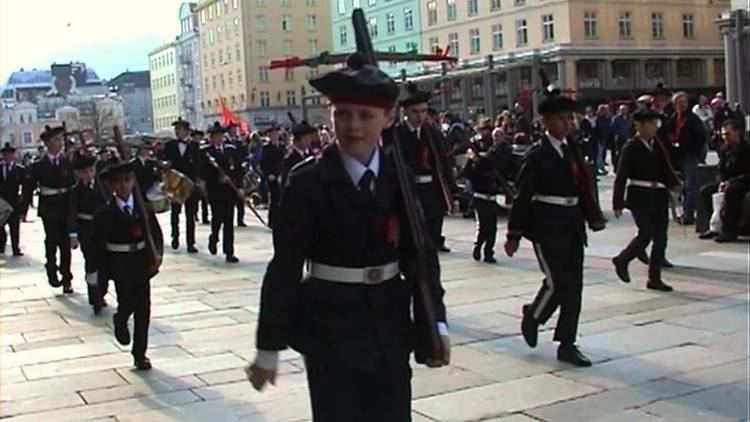 | ||
Skansen bataljon buekorps bergen
Buekorps ([ˈbʉːəˌkɔrps], literally "Bow Corps" or "Archery Brigade") are traditional marching neighbourhood youth organizations in Bergen, Norway.
Contents
- Skansen bataljon buekorps bergen
- Skutevikens buekorps avsluttning
- Background
- History
- Lrdagskorps and Sndagskorps
- The current brigades
- Former brigades in Bergen
- Former brigades in other cities
- References
The tradition is unique to Bergen. The organizations, which are called "bataljoner" ("battalions"), were first formally organized in the 1850s and are run entirely by the youths themselves. 14 different such "battalions" are active in Bergen, each belonging to a certain part of town.

In the past brigades were also formed in other Norwegian cities. But probably from the lacking city- and neighbourhood-patriotism, these were mostly defunct by the early 20th century.

Though the structure and ceremony of the Buekorps has military roots, the brigades are active in various other ways, ranging from physical activity and play to charitable work. Members range in age from about 7 to over 20, and adult veterans play a role in supporting the organizations and during certain events.

The groups consist of privates (usually carrying wooden rifles or crossbows), officers (the oldest kids with most seniority) and drummers. The buekorps have their official season from March through the summer, but are most active during spring, with Norwegian Constitution Day on May 17 as the high point of the season. On that day they are a prominent and popular part of the parade through the streets of Bergen.

In addition, the buekorps have their own celebratory days. One of these is the day they celebrate the founding date of their battalion. Every fourth year is Buekorpsenes Dag (The Buekorps Day), a series of competitions and pageantry.

Skutevikens buekorps avsluttning
Background

The tradition dates back at least to the 19th century when children would imitate the adult militia soldiers performing close order drill.
Even from back to the days of Ludvig Holberg it is told of boys playing and marching on the streets of Bergen. The city militia fascinated boys in the 18th and 19th century. They would build their own "fortresses" where they would play and engage in "warfare" against other boy-gangs. Consul August Konow tells from his lifetime that at the end of the 18th century there existed boy-gangs and companies who marched around and engaded in "warfare" with each other. These gangs were called "Nordnæs Kompani" and "Nykirkealmeningens Kompani" and were direct copies of the town militia.
Governor Fredrik Hauch also tells from the same time about boy-gangs who were copying the town milita. Names like "fjeldeguttene" ("the Fjeldet-boys"), "markeguttene" ("the Marken-boys") and "dræggaguttene" ("the Dræggen-boys") were known at the end of the 18th century.
Johan Sebastian Welhaven with his poem "børnelege" ("child games") from 1839 gives a picture of his childhood-years in 1814:
"Vi stilledes os siden i lange Rader, marsjerende tappert i byens gader ;vi plyndrede Søstrenes Dukkeskrin og gjorde Mundurer av silke og lin. I krigsraadet taltes med megen vekt om fienden stilling og skjulte planer, paa chefens kommando, vi stormede kjækt med skillingstrompeter, karduspapirfaner".
("We organized ourselves in long rows, marched bravely the streets of the city; we plundered our sisters doll-boxes and made coats out of silk and linen. In the council of war we gravely discussed the enemy's position and secret plans, and on the command of the chief we charged with shilling trumpets and paper banners".)
Nils Hertzberg says of the 1830s: There were organized boy-gangs in the different neighbourhoods which under changing alliances delivered each other full-blown battles: The Nordnæs-, Drægge-, Nøste- and Skive-Boys. They employed guards and scouts who made strategic moves to surprise the enemy.
In the 1850s these boy-gangs still rampaged, but the violent and hostile line had to come to an end. Who it was that finally ended these hostilities and turned into more like the current peaceful boy-organizations of buekorps is uncertain.
History
Traditionally an activity exclusively for boys, the first girl buekorps was formed in 1991. This stirred some controversy in Bergen, but the girl and mixed gender battalions are now accepted by most people.
The buekorps tradition, even with many battalions experiencing trouble in keeping up the recruiting of new members, continues to be a popular and proud feature of Bergen, excepting the odd complaint about noise.
Lørdagskorps and Søndagskorps
Lørdagskorps ("Saturday-brigades") and Søndagskorps ("Sunday-brigades") are historically the two main types of buekorps. These terms originate from the day the brigades marched on. Saturday-brigades were composed of the sons of those who could afford to take a day off on Saturday to march. The three surviving Saturday-brigades are Nordnæs Bataillon, Nygaards Bataljon and Dræggens Buekorps.
Sunday-brigades were the ones from working-class neighbourhoods where the children had to work on Saturdays, and thus could not march on any other day. Most of the brigades were Sunday-brigades. Some of these brigades came from such poor families that they could not afford real uniforms, wearing instead ornate shirts. Today, Laksevågs Bueskyttere and Løvstakkens Jægerkorps still march in these shirts.
The current brigades
Former brigades in Bergen
Since the 1850s there may have existed more than 200 different brigades overall. Dates of foundation and discontinuation are very scarcely known. Known brigades are listed here:
Former brigades in other cities
In the past there have also existed buekorps in other cities. However, they were mostly defunct by the early 20th century. It is somewhat uncertain to what degree all of these were to the original tradition of buekorps. They did anyways start after inspiration of the buekorps of Bergen. Known ones are listed here:
